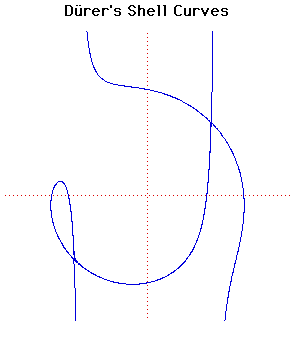Curves
Durer's Shell Curves

- Cartesian equation:
Description
These curves appear in Dürer's work Instruction in measurement with compasses and straight edge(1525).Dürer calls the curve 'ein muschellini' which means a conchoid, but since it is not a true conchoid we have called it Dürer's shell curve (muschellini = conchoid = shell).
This curve arose from Dürer's work on perspective. He constructed the curve in the following way. He drew lines and of length 16 units through and where . The locus of and as and move on the axes is the curve. Dürer only found one of the two branches of the curve.
The envelope of the line is a parabola and the curve is therefore a glissette of a point on a line segment sliding between a parabola and one of its tangents.
There are a number of interesting special cases:
In the above formula we have:
: Curve becomes two coincident straight lines.
: Curve becomes the line pair
together with the circle .
: The curve has a cusp at .